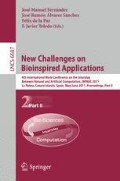Abstract
Saving earth’s biodiversity for future generations is an important global task. Spiders are creatures with a fascinating behaviour, overall in the way they build their webs. This is the reason this work proposed a novel problem: the used of spider webs as a source of information for specie recognition. To do so, biometric techniques such as image processing tools, Principal Component Analysis, and Support Vector Machine have been used to build a spider web identification system. With a database built of images from spider webs of three species, the system reached a best performance of 95,44 % on a 10 K-Folds cross-validation procedure.
Access this chapter
Tax calculation will be finalised at checkout
Purchases are for personal use only
Preview
Unable to display preview. Download preview PDF.
References
Sytnik, K.M.: Preservation of biological diversity: Top-priority tasks of society and state. Ukrainian Journal of Physical Optics 11(suppl.1), S2–S10 (2010)
Carvalho, J.C., Cardoso, P., Crespo, L.C., Henriques, S., Carvalho, R., Gomes, P.: Biogeographic patterns of spiders in coastal dunes along a gradient of mediterraneity. Biodiversity and Conservation, 1–22 (2011)
Johnston, J.M.: The contribution of microarthropods to aboveground food webs: A review and model of belowground transfer in a coniferous forest. American Midland Naturalist 143, 226–238 (2000)
Peterson, A.T., Osborne, D.R., Taylor, D.H.: Tree trunk arthropod faunas as food resources for birds. Ohio Journal of Science 89(1), 23–25 (1989)
Cardoso, P., Arnedo, M.A., Triantis, K.A., Borges, P.A.V.: Drivers of diversity in Macaronesian spiders and the role of species extinctions. J. Biogeogr. 37, 1034–1046 (2010)
Finch, O.-D., Blick, T., Schuldt, A.: Macroecological patterns of spider species richness across Europe. Biodivers. Conserv. 17, 2849–2868 (2008)
Eberhard, W.G.: Behavioral Characters for the Higher Classification of Orb-Weaving Spiders. Evolution 36(5), 1067–1095 (1982); Society for the Study of Evolution
Eberhard, W.G.: Early Stages of Orb Construction by Philoponella Vicina, Leucauge Mariana, and Nephila Clavipes (Araneae, Uloboridae and Tetragnathidae), and Their Phylogenetic Implications. Journal of Arachnology 18(2), 205–234 (1990)
Eberhard, W.G.: Computer Simulation of Orb-Web Construction. J. American Zoologist, 229–238 (February 1,1969)
Suresh, P.B., Zschokke, S.: A computerised method to observe spider web building behaviour in a semi-natural light environment. In: 19th European Colloquium of Arachnology, Aarhus, Denmark (2000)
Jolliffe, I.T.: Principal Component Analysis, 2nd edn. Springer Series in Statistics (2002)
Hu, J., Si, J., Olson, B.P., He, J.: Feature detection in motor cortical spikes by principal component analysis. IEEE Transactions on Neural Systems and Rehabilitation Engineering 13(3), 256–262 (2005)
Zhang, Q., Leung, Y.W.: A class of learning algorithms for principal component analysis and minor component analysis. IEEE Transactions on Neural Networks 11(1), 200–204 (2000)
Langley, P., Bowers, E.J., Murray, A.: Principal Component Analysis as a Tool for Analyzing Beat-to-Beat Changes in ECG Features: Application to ECG-Derived Respiration. IEEE Transactions on Biomedical Engineering 57(4), 821–829 (2010)
Yao, H., Tian, L.: A genetic-algorithm-based selective principal component analysis (GA-SPCA) method for high-dimensional data feature extraction. IEEE Transactions on Geoscience and Remote Sensing 41(6), 1469–1478 (2003)
Liu, N., Wang, H.: Feature Extraction with Genetic Algorithms Based Nonlinear Principal Component Analysis for Face Recognition. In: 18th International Conference on Pattern Recognition, ICPR 2006, vol. 3, pp. 461–464 (2006)
Vapnik, V.: The Nature of Statistical learning Theory. Springer, New York (1995)
Kevman, V.: Learning and Soft Computing: Support Vector Machines, Neural Networks, and Fuzzy Logic models. The MIT Press, Cambridge (2001)
Schölkopfy, B., Smola, A.J.: Learning with Kernels. Support Vector Machines, Regularization, Optimization, and Beyond. The MIT Press, Cambridge (2002)
Suykens, J.A.K., Van Gestel, T., De Brabanter, J., De Moor, B., Vandewalle, J.: Least Squares Support Vector Machines. World Scientific, Singapore (2002); ISBN 981-238-151-1
Author information
Authors and Affiliations
Editor information
Editors and Affiliations
Rights and permissions
Copyright information
© 2011 Springer-Verlag Berlin Heidelberg
About this paper
Cite this paper
Ticay-Rivas, J.R., del Pozo-Baños, M., Eberhard, W.G., Alonso, J.B., Travieso, C.M. (2011). Spider Recognition by Biometric Web Analysis. In: Ferrández, J.M., Álvarez Sánchez, J.R., de la Paz, F., Toledo, F.J. (eds) New Challenges on Bioinspired Applications. IWINAC 2011. Lecture Notes in Computer Science, vol 6687. Springer, Berlin, Heidelberg. https://doi.org/10.1007/978-3-642-21326-7_44
Download citation
DOI: https://doi.org/10.1007/978-3-642-21326-7_44
Publisher Name: Springer, Berlin, Heidelberg
Print ISBN: 978-3-642-21325-0
Online ISBN: 978-3-642-21326-7
eBook Packages: Computer ScienceComputer Science (R0)

